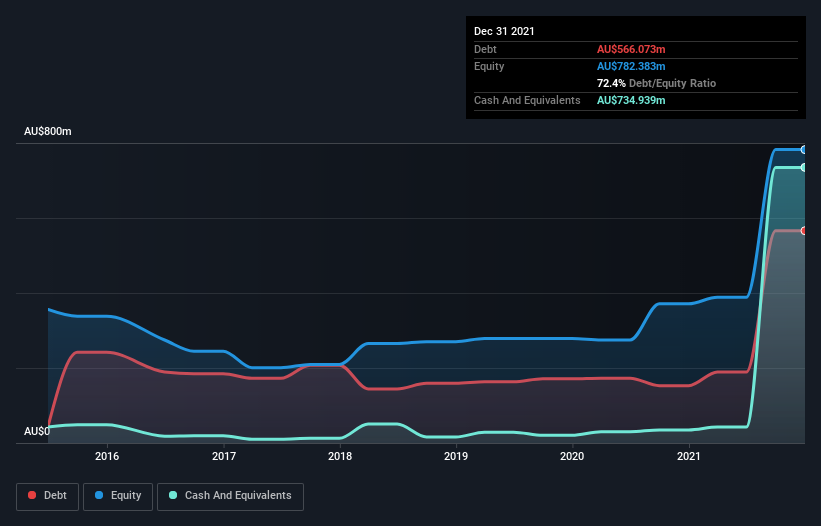These 4 Measures Indicate That GUD Holdings (ASX:GUD) Is Using Debt Safely
The external fund manager backed by Berkshire Hathaway's Charlie Munger, Li Lu, makes no bones about it when he says 'The biggest investment risk is not the volatility of prices, but whether you will suffer a permanent loss of capital.' When we think about how risky a company is, we always like to look at its use of debt, since debt overload can lead to ruin. We can see that GUD Holdings Limited (ASX:GUD) does use debt in its business. But is this debt a concern to shareholders?
When Is Debt Dangerous?
Generally speaking, debt only becomes a real problem when a company can't easily pay it off, either by raising capital or with its own cash flow. Ultimately, if the company can't fulfill its legal obligations to repay debt, shareholders could walk away with nothing. However, a more usual (but still expensive) situation is where a company must dilute shareholders at a cheap share price simply to get debt under control. Having said that, the most common situation is where a company manages its debt reasonably well - and to its own advantage. When we examine debt levels, we first consider both cash and debt levels, together.
Check out our latest analysis for GUD Holdings
What Is GUD Holdings's Net Debt?
The image below, which you can click on for greater detail, shows that at December 2021 GUD Holdings had debt of AU$566.1m, up from AU$152.9m in one year. But on the other hand it also has AU$734.9m in cash, leading to a AU$168.9m net cash position.
How Strong Is GUD Holdings' Balance Sheet?
Zooming in on the latest balance sheet data, we can see that GUD Holdings had liabilities of AU$171.2m due within 12 months and liabilities of AU$700.1m due beyond that. Offsetting these obligations, it had cash of AU$734.9m as well as receivables valued at AU$153.8m due within 12 months. So its total liabilities are just about perfectly matched by its shorter-term, liquid assets.
Having regard to GUD Holdings' size, it seems that its liquid assets are well balanced with its total liabilities. So it's very unlikely that the AU$1.66b company is short on cash, but still worth keeping an eye on the balance sheet. Simply put, the fact that GUD Holdings has more cash than debt is arguably a good indication that it can manage its debt safely.
Another good sign is that GUD Holdings has been able to increase its EBIT by 28% in twelve months, making it easier to pay down debt. When analysing debt levels, the balance sheet is the obvious place to start. But ultimately the future profitability of the business will decide if GUD Holdings can strengthen its balance sheet over time. So if you're focused on the future you can check out this free report showing analyst profit forecasts.
Finally, a company can only pay off debt with cold hard cash, not accounting profits. GUD Holdings may have net cash on the balance sheet, but it is still interesting to look at how well the business converts its earnings before interest and tax (EBIT) to free cash flow, because that will influence both its need for, and its capacity to manage debt. During the last three years, GUD Holdings produced sturdy free cash flow equating to 65% of its EBIT, about what we'd expect. This cold hard cash means it can reduce its debt when it wants to.
Summing up
While it is always sensible to investigate a company's debt, in this case GUD Holdings has AU$168.9m in net cash and a decent-looking balance sheet. And it impressed us with its EBIT growth of 28% over the last year. So is GUD Holdings's debt a risk? It doesn't seem so to us. When analysing debt levels, the balance sheet is the obvious place to start. But ultimately, every company can contain risks that exist outside of the balance sheet. For instance, we've identified 2 warning signs for GUD Holdings (1 doesn't sit too well with us) you should be aware of.
At the end of the day, it's often better to focus on companies that are free from net debt. You can access our special list of such companies (all with a track record of profit growth). It's free.
Have feedback on this article? Concerned about the content? Get in touch with us directly. Alternatively, email editorial-team (at) simplywallst.com.
This article by Simply Wall St is general in nature. We provide commentary based on historical data and analyst forecasts only using an unbiased methodology and our articles are not intended to be financial advice. It does not constitute a recommendation to buy or sell any stock, and does not take account of your objectives, or your financial situation. We aim to bring you long-term focused analysis driven by fundamental data. Note that our analysis may not factor in the latest price-sensitive company announcements or qualitative material. Simply Wall St has no position in any stocks mentioned.

 Yahoo Finance
Yahoo Finance 
